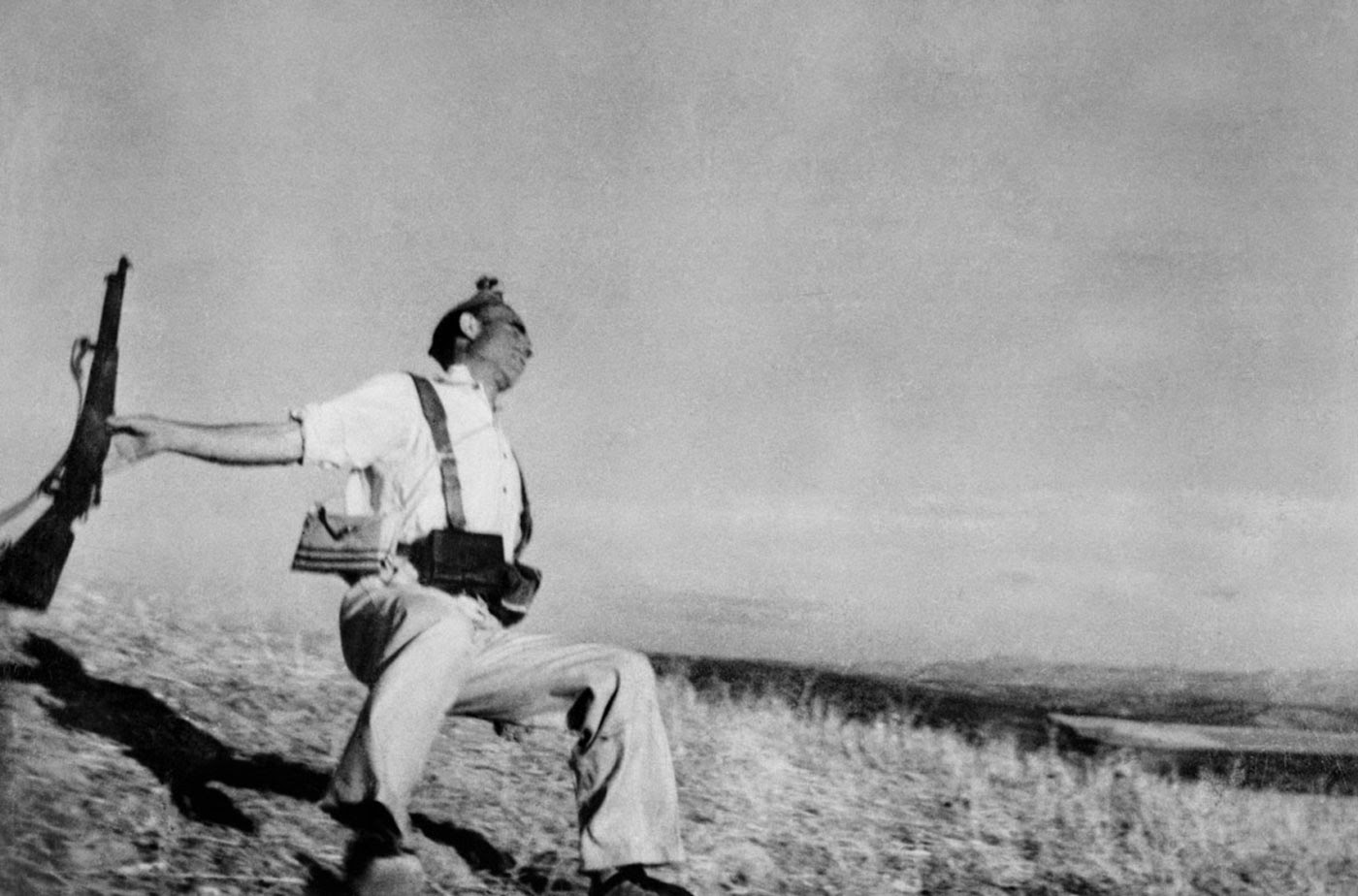The Falling Soldier: The story behind this iconic photograph, 1936
.jpg)
The Falling Soldier became famous for the way it captures with terrifying urgency, the moment a bullet fatally strikes a Spanish loyalist militiaman; Later, it became famous for allegations that the picture was "fake", or at least staged (although this was common practice at the time).
The soldier is falling backwards due to a fatal bullet in the head. He is wearing civilian-looking clothing but a leather cartridge belt, and his rifle is slipping through his right hand. This photo was taken by Hungarian Jewish photographer Robert Capa. From 1936 to 1939, Capa worked in Spain, photographing the Spanish Civil War.
It was thought to have been taken on September 5, 1936, and was long thought to depict the death of a Republican during the Spanish Civil War. He was later identified as an anarchist militiaman Federico Borrell García (although this is still disputed).
The original title of the picture is "Death loyal militiaman, Cerro Muriano, September 5, 1936". The story behind this picture is very complex and controversial.
Some historians say it is real, some others say it is staged. Sometimes the truth is stranger than fiction. However, one thing is true, the photo was not taken on Cerro Muriano, but in the village of Espejo.
In 1936 the photographers Robert Capa and Gerda Taro do their work at the Cordoba Front. On 5 September, Nationalist Breguet bombers began attacking government troops encamped in the hills near the copper-mining village of Cerro Muriano, north of Córdoba.
By mid-morning the rebel forces, who had launched their attack from Córdoba, had brought in artillery and were shelling both the village and the Loyalist camp. By mid-afternoon, when the Nationalist infantry arrived with their machine guns, there was a stir in the place.
At that time the rebels retired to Córdoba for the night; But they would return the next day what they had started and repatriate the remains of the government detachment to their base camp in Montoro, 43 km to the east.
After being there for some time and unable to capture the shots they were looking for, Capa and Taro set out to the southwest of Montoro, across Guadalquivir and through rolling hills covered with wheat fields, so far after the harvest, until they reached one's camp. A small contingent of CNT militia outside the farming village of Espejo.
The trip was not without danger: just a few days earlier, another journalist, Renee Lafont, was fatally shot in a nearby rebel ambush.
The military personnel stationed there were happy to pose for the photographers. and their prince challenged them and climbed up one of the mountains; Kneel on the grass to aim his rifles at the distant target on the next hill; stood on the edge of a dusty ditch and waved his guns in a show of macho bravado.
Finally, either Capa or Tarot asked if some militiano would simulate being hit by bullets. One of the soldiers, with a slender, enlarged face and heavy black eyebrows, with a white shirt under the straps of his leather cartridge box, came down from the slope of the sunlight, his rifle in his right hand, his The soles of the shoe rope were uprooted dry grass.
And then something happened. Was there any report, sharp crack of rifle fire? Because suddenly the man's legs became loose, his hands were paralyzed; Flying the rifle with his loose fingers, he also fell on the ground.
And in the seconds before the soldier fell, Capa squeezed his Leica shutter and became one of the world's most famous photographs.
The photograph was first published in the September 23, 1936 issue of the French magazine "Vu", with the provocative text: "With lively steps, caressing the wind, clutching their rifles, they descended from a slope covered with thick stubble. ran downstairs. Suddenly his flight was interrupted, a bullet whistled, a fraternal shot, and his blood was drunk from his motherland".
Later, in 1937, Life magazine transformed the image of The Falling Soldier into a symbol of the Spanish conflict by creating a visual epigraph for its editorial summary of the war.
There have been doubts about the authenticity of the picture since 1975. The 2007 documentary La sombra del iceberg claims that the picture was staged and that Borrell is not the person in the picture.
In his 2009 book, Sombras de la Fotografia ("Shadow of Photography"), José Manuel Sasperegui of the University of Pas Vasco concluded that the photograph was taken not in Cerro Muriano but at another location 35 miles (56 km) away. .
Sasparregui determined the actual location of the picture by examining the background of other photographs in the same sequence as in The Falling Soldier, in which a range of mountains can be seen.
It was concluded that the scenario was from Espejo. Willis E. Hartshorne, director of the International Center of Photography, suggested that the militiaman had been killed by a sniper firing from afar while posing for a staged photograph, while emphasizing the authenticity of the photograph.
.jpg)
No comments: